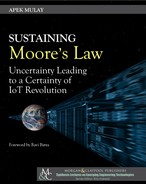
53
C H A P T E R 9
Moore’s Law Beyond 50
9.1 INTRODUCTION
In 1995, at his speech in the SPIE (e International Society for Optical Engineering) con-
ference, Intel co-founder Gordon Moore hesitated to review the origins of Moore’s Law and
thereby restrict the definition of it. While resolving the contributing factors to the progress of
Moore’s Law, Moore realized that the semiconductor industry not only progressed to larger di-
ameter silicon wafers, but simultaneously evolved into finer and finer dimensions. He attributed
the contributions to increased complexity arising from increasing density of chips to be “circuit
and device cleverness.” Moore attributed 60% of the progress of Moore’s Law to die size and finer
structures and the remaining 40% to circuit cleverness.
Although Moore acknowledged that it was hard to predict beyond the next couple of gen-
erations, he considers it to be a spectacular achievement of the semiconductor industry to stay on
the exponential so long. However, Moore is concerned about the increasing costs of the equip-
ment for every generation of technological progress. At his speech at the 1995 SPIE conference,
Moore said:
“e people at this conference are going to have to come up with something new to keep us on
the long-term trend. Capital costs are rising far faster than revenue in the industry. We can
no longer make up for the increasing cost by improving yields and equipment utilization.
Like the ‘cleverness’ term in device complexity disappeared when there was no more room
to be clever, there is little room left in manufacturing efficiency.”
is chapter explains the contributing factors to the progress of Moore’s Law over the years
and how this law could continue in this era of dwindling returns on investments.
9.2 POTENTIAL CONTRIBUTIONS OF THE
SEMICONDUCTOR INDUSTRY TO THE GLOBAL
ECONOMY
In 1986, the Semiconductor industry represented just 0.1% of gross world product (GWP). In
2005, the contribution of this industry accounted for 1% of GWP. e Industry stays on this path
of progress and is able to sustain the progress of Moore’s Law, the contribution to GWP would
be close to 10%. e information technology (IT) revolution, with the IoT and big data being the
major contributors to the next digital economy, has a potential to sustain the progress of Moore’s
Law, making it one of the biggest industries in this world.
..................Content has been hidden....................
You can't read the all page of ebook, please click here login for view all page.
